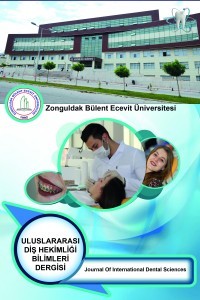İki Rezin Simanın Farklı Metal Alaşımlara Makaslama Bağlanma Dayanımlarının Karşılaştırılması
makaslama bağlanma dayanımı, kobalt-krom, titanyum
A Comparison of Shear Bond Strength of Two Resin Cements to Different Metal Alloys
shear bond stength, cobalt-chromium, titanium,
___
- 1. Kocaagaoglu H, Albayrak H, Kilinc HI, Gumus HO. Effect of repeated ceramic firings on the marginal and internal adaptation of metal-ceramic restorations fabricated with different CAD-CAM technologies. J Prosthet Dent 2017; 118 (5): 672-7.
- 2. Musani S, Musani I, Dugal R, Habbu N, Madanshetty P, Virani D. An in vitro comparative evaluation of micro tensile bond strength of two metal bonding resin cements bonded to cobalt chromium alloy. J Int Oral Health 2013; 5 (5): 73-8.
- 3. Ates SM, Korkmaz FM, Caglar IS, Duymus ZY, Turgut S, Bagis EA. The effect of ultrafast fiber laser application on the bond strength of resin cement to titanium. Lasers Med Sci 2017; 32 (5): 1121-9.
- 4. Antanasova M, Kocjan A, Kovac J, Zuzek B, Jevnikar P. Influence of thermo-mechanical cycling on porcelain bonding to cobalt-chromium and titanium dental alloys fabricated by casting, milling, and selective laser melting. J Prosthodont Res 2018; 62 (2): 184-94.
- 5. Guilherme N, Wadhwani C, Zheng C, Chung KH. Effect of surface treatments on titanium alloy bonding to lithium disilicate glass-ceramics. J Prosthet Dent 2016; 116 (5): 797-802.
- 6. Parchanska-Kowalik M, Wolowiec-Korecka E, Klimek L. Effect of chemical surface treatment of titanium on its bond with dental ceramics. J Prosthet Dent 2018; 120(3): 470-5.
- 7. Onoral O, Ulusoy M, Seker E, Etikan I. Influence of repeated firings on marginal, axial, axio-occlusal, and occlusal fit of metal-ceramic restorations fabricated with different techniques. J Prosthet Dent 2018; 120 (3): 415-20.
- 8. Ucar Y, Ekren O. Effect of layered manufacturing techniques, alloy powders, and layer thickness on mechanical properties of Co-Cr dental alloys. J Prosthet Dent 2018; 120(5): 762-70.
- 9. Oilo M, Nesse H, Lundberg OJ, Gjerdet NR. Mechanical properties of cobalt-chromium 3-unit fixed dental prostheses fabricated by casting, milling, and additive manufacturing. J Prosthet Dent 2018; 120 (1): 156 e1-156 e7.
- 10. Svanborg P, Eliasson A, Stenport V. Additively manufactured titanium and cobalt-chromium implant frameworks: fit and effect of ceramic veneering. Int J Oral Maxillofac Implants 2018; 33(3): 590-6.
- 11. Kocaagaoglu H, Kilinc HI, Albayrak H, Kara M. In vitro evaluation of marginal, axial, and occlusal discrepancies in metal ceramic restorations produced with new technologies. J Prosthet Dent 2016; 116 (3): 368-74.
- 12. Jang SH, Lee DH, Ha JY, Hanawa T, Kim KH, Kwon TY. Preliminary evaluation of mechanical properties of Co-Cr alloys fabricated by three new manufacturing processes. Int J Prosthodont 2015; 28 (4): 396-8.
- 13. Vojdani M, Torabi K, Atashkar B, Heidari H, Torabi Ardakani M. A comparison of the marginal and internal fit of cobalt- chromium copings fabricated by two different CAD/CAM systems (CAD/ Milling, CAD/ Ceramill Sintron). J Dent 2016; 17 (4): 301-8.
- 14. Kim KB, Kim JH, Kim WC, Kim JH. Three-dimensional evaluation of gaps associated with fixed dental prostheses fabricated with new technologies. J Prosthet Dent 2014; 112(6): 1432-6.
- 15. Kim EH, Lee DH, Kwon SM, Kwon TY. A microcomputed tomography evaluation of the marginal fit of cobalt-chromium alloy copings fabricated by new manufacturing techniques and alloy systems. J Prosthet Dent 2017; 117 (3): 393-9.
- 16. Ezoji F, Tabari K, Jaberi Ansari Z, Torabzadeh H, Kharrazi Fard MJ. Shear bond strength of a resin cement to different alloys subjected to various surface treatments. J Dent (Tehran) 2016; 13(1): 29-39.
- 17. Hattar S, Hatamleh M, Khraisat A, Al-Rabab'ah M. Shear bond strength of self-adhesive resin cements to base metal alloy. J Prosthet Dent 2014; 111(5): 411-5.
- 18. Fujimori K, Arita A, Kumagai T. Evaluation of bonding properties of G-Cem linkforce to ceramic restorations. Dent Mater 2016, 32 (Supplement 1), e28-e29.
- 19. Zorzin J, Belli R, Wagner A, Petschelt A, Lohbauer U. Self-adhesive resin cements: adhesive performance to indirect restorative ceramics. J Adhes Dent 2014; 16(6): 541-6.
- 20. Sabatini C, Patel M, D'Silva E. In vitro shear bond strength of three self-adhesive resin cements and a resin-modified glass ionomer cement to various prosthodontic substrates. Oper Dent 2013; 38(2): 186-96.
- ISSN: 2149-8628
- Yayın Aralığı: Yılda 3 Sayı
- Yayıncı: Zonguldak Bülent Ecevit Üniversitesi
Süt Dişlerine Gelen Travmalara Bağlı Daimi Dişlerde Oluşan Gelişimsel Defektler: Üç Olgu Raporu
GUMMY SMİLE’DA ETKİN ÇÖZÜM: BOTOKS
Travma Sebebiyle Meydana Gelmiş Oronazal Fistülün Cerrahi Tedavisi: Vaka Raporu
Yatay Alveoler Distraksiyon Osteogenezi Tekniğinde Yeni Kemik Oluşumu
İki Rezin Simanın Farklı Metal Alaşımlara Makaslama Bağlanma Dayanımlarının Karşılaştırılması
